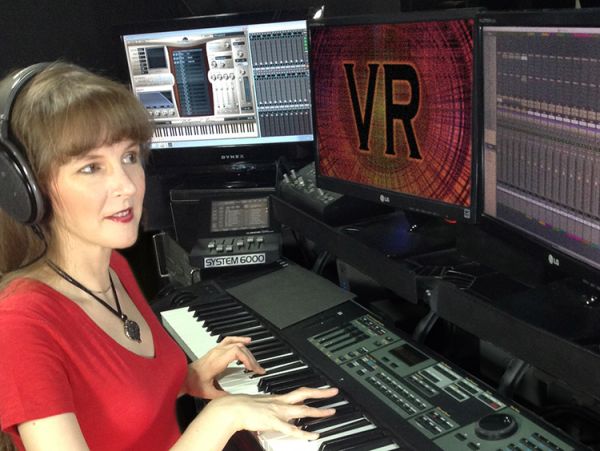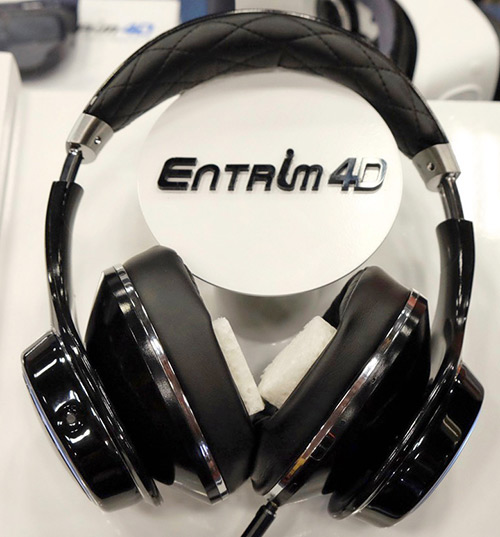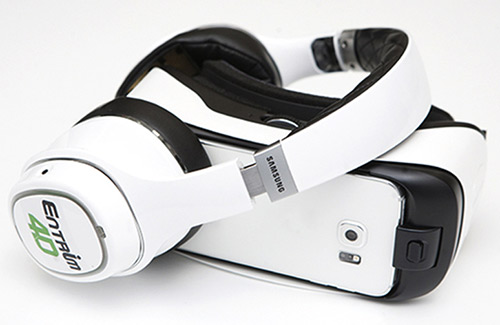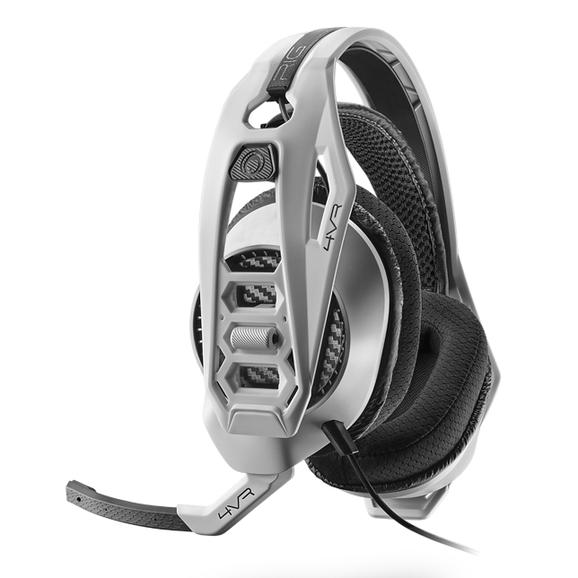Trending
Opinion: How will Project 2025 impact game developers?
The Heritage Foundation's manifesto for the possible next administration could do great harm to many, including large portions of the game development community.

Featured Blog | This community-written post highlights the best of what the game industry has to offer. Read more like it on the Game Developer Blogs or learn how to Submit Your Own Blog Post
This article by video game music composer Winifred Phillips explores the technology of audio headphones built specifically for virtual reality. Topics include galvanic vestibular stimulation, VR motion sickness issues and ergonomic design considerations.

 My work as a video game composer has lately included some projects for virtual reality games (more info on that in the coming months), and as a result I've been thinking a lot about the awesome potential of VR, and have also been writing lots of articles on the subject.
My work as a video game composer has lately included some projects for virtual reality games (more info on that in the coming months), and as a result I've been thinking a lot about the awesome potential of VR, and have also been writing lots of articles on the subject.
Earlier this month I began a two-part article that focuses on the experience of the end user, and the gear with which they'll be enjoying our video game music and audio content (you can read part one here).
So, let's now continue our discussion about the new generation of headphones designed specifically for VR!
In this article, we'll be discussing two headphone models:
Entrim 4D
Plantronics RIG 4VR
So let's get underway!
 This March at the famous SXSW convention in Austin, Samsung showed off a piece of experimental technology promising to bring a new dimension of immersion to virtual reality. It's designed specifically to complement their popular Samsung Gear VR device, and it works by virtue of electrodes that send electrical signals right into the wearer's head! As if virtual reality itself weren't futuristic enough, now we're talking about a device that zaps us to make the VR feel more real! It's called Entrim 4D (pictured right). We're talking about it here because (among other things) Entrim 4D is a pair of audio headphones built specifically for VR.
This March at the famous SXSW convention in Austin, Samsung showed off a piece of experimental technology promising to bring a new dimension of immersion to virtual reality. It's designed specifically to complement their popular Samsung Gear VR device, and it works by virtue of electrodes that send electrical signals right into the wearer's head! As if virtual reality itself weren't futuristic enough, now we're talking about a device that zaps us to make the VR feel more real! It's called Entrim 4D (pictured right). We're talking about it here because (among other things) Entrim 4D is a pair of audio headphones built specifically for VR.
The Entrim 4D headphones work by virtue of Galvanic Vestibular Stimulation, a process wherein low level electrical impulses are directed into the wearer's inner ear. Reaching the nerve in the ear that enables humans to regulate their sense of balance, this subtle electrical pulse can create specific sensations of movement for the wearer, as well as alterations in the wearer's sense of personal orientation. In other words, the pulses can make us feel like we're leaning or moving in any direction.
In an interview with tech journalist Ben Popper of The Verge, Entrim 4D's creative lead Steve Jung describes the top goals of the project. "Virtual reality shouldn’t be experienced only with the eyes," says Jung. "With Entrim 4D, we hope that people can experience VR the way it was meant to be—with their whole bodies."
 At SXSW, journalist Karissa Bell of Mashable.com gave the Entrim 4D headphones a test drive. "I started the demo, which was a first person view of driving around a race track," she writes. "The demo switched between turning the motion effects on and off and the difference was dramatic. When the effects were on, I found that not only did it feel more realistic, I was far better at steering myself around the track."
At SXSW, journalist Karissa Bell of Mashable.com gave the Entrim 4D headphones a test drive. "I started the demo, which was a first person view of driving around a race track," she writes. "The demo switched between turning the motion effects on and off and the difference was dramatic. When the effects were on, I found that not only did it feel more realistic, I was far better at steering myself around the track."
This same technology has been in experimental use for many years, and hasn't always created the most positive experiences for the wearer. In 2005, Associated Press correspondent Yuri Kagayama describes her experience wearing a similar headset developed by the Nippon Telegraph & Telephone Corp. in Japan. "I found the experience unnerving and exhausting: I sought to step straight ahead but kept careening from side to side. Those alternating currents literally threw me off." Later, she describes wearing the headphones while watching a game demo. "I watched a simple racing-car game demonstration on a large screen while wearing a device programmed to synchronize the curves with galvanic vestibular stimulation. It accentuated the swaying as an imaginary racing car zipped through a virtual course, making me wobbly."
 For the Entrim 4D headset, the project team at Samsung have been hard at work refining this technology. Their staff of engineers and biomedical experts have run multiple experiments on over 1,500 test subjects. The results of those experiments have allowed the team to refine the electrical signals to deliver the sensation of 30 distinct patterns of movement. They're currently working to add additional electrodes that can induce the sense of rotation - as if the Entrim 4D wearer had started spinning.
For the Entrim 4D headset, the project team at Samsung have been hard at work refining this technology. Their staff of engineers and biomedical experts have run multiple experiments on over 1,500 test subjects. The results of those experiments have allowed the team to refine the electrical signals to deliver the sensation of 30 distinct patterns of movement. They're currently working to add additional electrodes that can induce the sense of rotation - as if the Entrim 4D wearer had started spinning.
One of the ultimate goals behind the Entrim 4D system is the cure for the motion sickness problem in VR. By reconciling visually perceived motion with physically perceived motion, the Entrim 4D team hopes to eliminate the cognitive dissonance that can lead to the woozy symptoms experienced by some VR users. In a press release, Samsung expressed its goals in regards to the motion sickness dilemma. "Unsurprisingly, the mental discrepancy of seeing yourself riding a roller coaster or zooming around a race track but not actually experiencing the movement can leave you nauseous," Samsung observes. "Entrim 4D, though still in a developmental phase, may well be able to present a new and practical solution."
Unfortunately, the team behind the Entrim 4D has revealed nothing about the audio capabilities of its headphones, concentrating solely on the Galvanic Vestibular Stimulation system. Since the headphones are still in development with no projected release date as of yet, we can expect to hear more about the audio side of the Entrim 4D headphones in the months ahead. In the meantime, here is a video showing users experiencing the Entrim 4D headphones first hand:
After the above discussion of a VR headset in a highly experimental stage, let's now take a look at a much more down-to-earth product that will be hitting retail this Holiday 2016 - the Plantronics RIG 4VR headphones.
 Plantronics is well known as a military contractor for audio technology. Its headphones equipment has a long history, is currently used heavily by air traffic controllers and aviators, and most notably by NASA during Neil Armstrong's famous "One small step for man" message from the moon. However, Plantronics has a strong presence in the consumer headphones industry and a large consumer product catalog, which includes their RIG line of gaming headsets. The newest entry in this product line, the RIG 4VR, is designed to accommodate one specific model of VR hardware - the PlayStation VR system.
Plantronics is well known as a military contractor for audio technology. Its headphones equipment has a long history, is currently used heavily by air traffic controllers and aviators, and most notably by NASA during Neil Armstrong's famous "One small step for man" message from the moon. However, Plantronics has a strong presence in the consumer headphones industry and a large consumer product catalog, which includes their RIG line of gaming headsets. The newest entry in this product line, the RIG 4VR, is designed to accommodate one specific model of VR hardware - the PlayStation VR system.
The PlayStation VR headset includes earbuds, but according to CNET's David Carnoy, some gamers will want more. "A lot of people will want to use better headphones that deliver a more immersive audio experience—or at least that's what Plantronics is hoping."
 While the previous headset systems we've discussed (both in this article and in the previous one) are all endowed with special aural or electrical features designed specifically for VR, the Plantronics RIG 4VR (pictured right) is customized in a much simpler way. Plantronics has focused on the form factor of the headphones, optimizing the ergonomics to allow the headphones to be comfortably worn by a gamer who is also wearing the PlayStation VR headset.
While the previous headset systems we've discussed (both in this article and in the previous one) are all endowed with special aural or electrical features designed specifically for VR, the Plantronics RIG 4VR (pictured right) is customized in a much simpler way. Plantronics has focused on the form factor of the headphones, optimizing the ergonomics to allow the headphones to be comfortably worn by a gamer who is also wearing the PlayStation VR headset.
It is worth noting that the other headphones we've previously discussed, while impressive in their features, can also be fairly large in both their earcups and their headbands. Plantronics observed that headphones with a bulky form factor have the potential to bump against a VR device, so they took steps to best address the problem.
 The earcups of the RIG 4VR are oval rather than round, in order to keep them out of the way of the PlayStation VR hardware. The earcups also allow the ambient sound of the room to filter through. Plantronics has an interesting theory about how this aural permeability may help alleviate VR sickness. "What we’ve found, this may actually help VR users for maintaining balance,” says Corey Rosemond, the head of global Esports for Plantronics, during an interview with UploadVR.com. “People don’t realize that subconsciously, what you hear and how noise sounds, that affects your balance. Being able to allow some of that in allows us to have some better balance from a VR perspective. It lessens the motion sickness just a bit."
The earcups of the RIG 4VR are oval rather than round, in order to keep them out of the way of the PlayStation VR hardware. The earcups also allow the ambient sound of the room to filter through. Plantronics has an interesting theory about how this aural permeability may help alleviate VR sickness. "What we’ve found, this may actually help VR users for maintaining balance,” says Corey Rosemond, the head of global Esports for Plantronics, during an interview with UploadVR.com. “People don’t realize that subconsciously, what you hear and how noise sounds, that affects your balance. Being able to allow some of that in allows us to have some better balance from a VR perspective. It lessens the motion sickness just a bit."
Plantronics also says that the vented earcup design helps to keep ears cooler, while also enabling players to conduct conversations when playing with other VR gamers in the same room. In addition, Plantronics hinted to CNET that their RIG 4VR headphones have been "tuned for PlayStation VR," but more specifics about that aural tuning were not made available.
When the RIG 4VR is released concurrently with the Playstation VR system this holiday season, we may learn more about this specific aural tuning for the PlayStation VR. For now, here's a "first look" video that shows the form factor of the RIG 4VR:
So that concludes this look at headphones designed specifically to accommodate the needs of virtual reality! I hope you enjoyed these two articles, and please feel free to let me know your thoughts in the comments below!
 Winifred Phillips is an award-winning video game music composer whose most recent project is the triple-A first person shooter Homefront: The Revolution. Her credits include five of the most famous and popular franchises in video gaming: Assassin’s Creed, LittleBigPlanet, Total War, God of War, and The Sims. She is the author of the award-winning bestseller A COMPOSER'S GUIDE TO GAME MUSIC, published by the Massachusetts Institute of Technology Press. As a VR game music expert, she writes frequently on the future of music in virtual reality video games.
Winifred Phillips is an award-winning video game music composer whose most recent project is the triple-A first person shooter Homefront: The Revolution. Her credits include five of the most famous and popular franchises in video gaming: Assassin’s Creed, LittleBigPlanet, Total War, God of War, and The Sims. She is the author of the award-winning bestseller A COMPOSER'S GUIDE TO GAME MUSIC, published by the Massachusetts Institute of Technology Press. As a VR game music expert, she writes frequently on the future of music in virtual reality video games.
Follow her on Twitter @winphillips.
Read more about:
Featured BlogsYou May Also Like